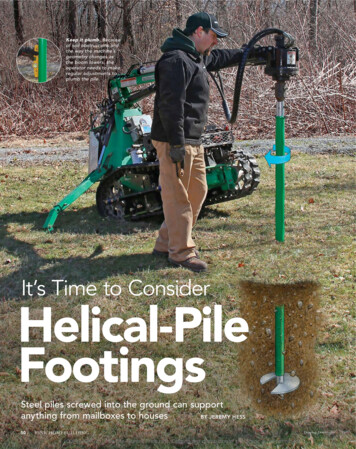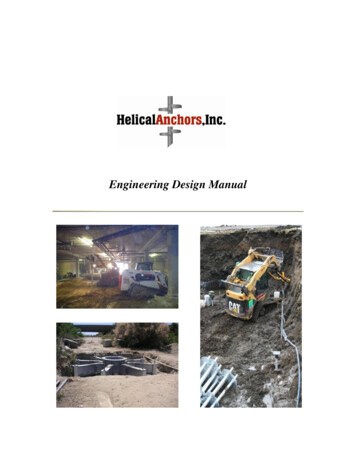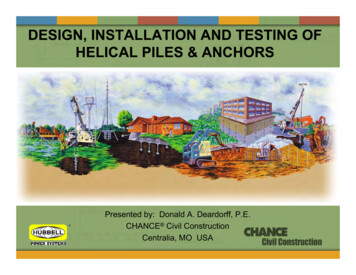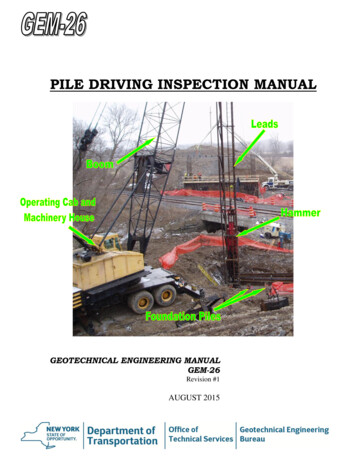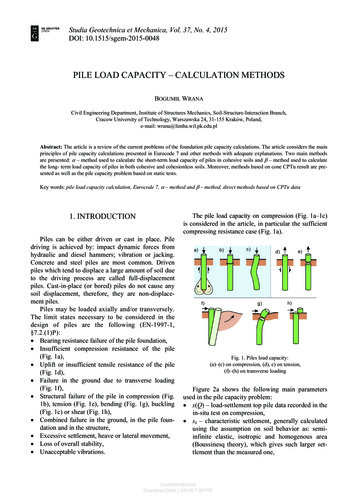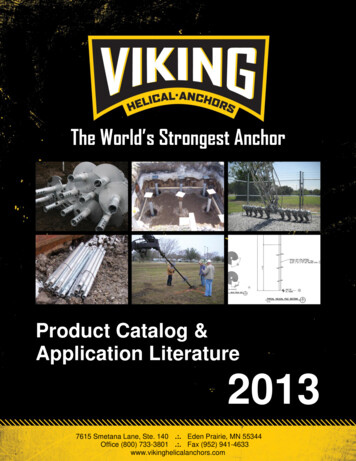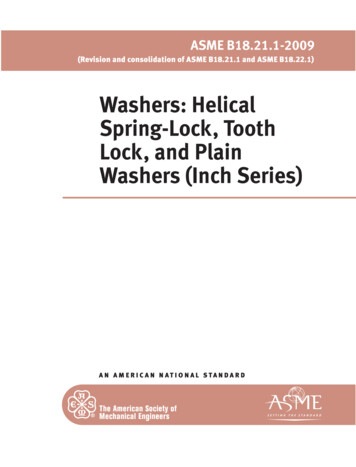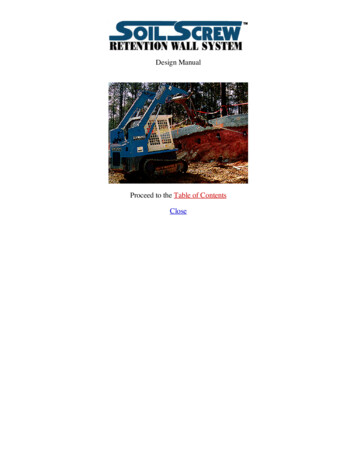
Transcription
Design ManualProceed to the Table of ContentsClose
Design ManualCloseTABLE OF CONTENTSLIST OF TABLESLIST OF FIGURESGLOSSARYCHAPTER 1.0Introduction and Applications1.1.0 - Purpose and Scope1.2.0 - Soil Nail Technology1.2.1 - History of Soil Nailing1.2.2 - Definition1.2.3 - Screw Anchor Soil Nails1.2.4 - Grouted Soil Nails1.2.5 - Comparison with Tieback Walls1.2.6 - Comparison with MSE Walls1.3 .0- Soil Nail Application1.4.0 - Advantages of Soil Nail Walls1.5.0 - LimitationsCHAPTER 2.0Soil Nailing with the SOIL SCREW Retention Wall System2.1.0 - Designing with the SOIL SCREW Retention Wall System2.1.1 - Facing Deformation2.1.2 - Pullout Resistance2.1.3 - Tensile Strength of a Screw Anchor2.2.0 - Data Required for Soil Nail Design2.2.1 - Soil Parameters2.2.2 - Surcharges and Loading Conditions2.2.3 - Drainage and Groundwater Conditions2.3 .0- Facing Considerations2.3.1 - Temporary Facings2.3.2 - Permanent FacingsFigures 2.3.4CHAPTER 3.0Design Guidelines for Soil Nailed Walls Utilizing theSOIL SCREW Retention Wall System3.1.0 - Site Investigation3.1.1 - Regional Geology3.1.2 - Field Reconnaissance3.1.3 - Subsurface Exploration3.1.4 - Laboratory Testing3.2.0 - Preliminary Feasibility Assessment
3.2.1 - Ground Conditions Best Suited for Soil Nailing with the0.0.0 - SOIL SCREW Retention Wall System3.2.2 - Ground Conditions Considered Not Favorable for Soil Nailing Usingthe0.0.0 - SOIL SCREW Retention Wall System3.2.3 - Design Charts3.3.0 - Overview of Design Methodology3.4.0 - External Stability3.4.1 - Earth Pressures for External Stability3.4.2 - Sliding Stability3.4.3 - Bearing Capacity3.5.0 - Internal Stability3.5.1 - Allowable Nail Strength3.5.2 - Pullout Capacity of Nail3.5.2.1 - Pullout of Screw Anchors in Sands and Silts3.5.3 - Facing Design3.5.3.1 - Flexural Strength of the Facing3.5.3.2 - Punching Shear Strength of the Facing3.5.4 - Cantilever Design Check3.5.5 - Nail Strength Envelope3.5.6 - Internal Stability Limit Equilibrium Analysis3.6.0 - Global Stability3.7.0 - Summarized Design Steps3.8.0 - Special Design Considerations3.8.1 - Tiered Walls3.8.2 - Surcharge LoadsFigure 3.8.1CHAPTER 4.0Construction - Materials, Installation and Monitoring4.1.0 - Materials4.1.1 - Screw Anchors4.1.2 - Wall Connectors4.1.3 - Shotcrete4.1.4 - Drainage Materials4.2.0 - Alternate Facing Materials4.3.0- Installation Equipment4.4.0 - Installation, Monitoring and Testing4.4.1 - Installation4.4.2 - Monitoring and TestingCHAPTER 5.0Specifications5.1 Product Specifications (Owner-Designed Walls with ProductSpecifications)5.2 Performance Specification (Design-Build Specification with PerformanceRequirements)CHAPTER 6.0
ReferencesAPPENDIX ADesign Charts and Design ExampleAppendix A1 - Design ChartsFigure A-1 SOIL SCREW Retention Wall System PreliminaryDesign Chart.Figure A-2 SOIL SCREW Retention Wall System PreliminaryDesign Chart.Figure A-3 SOIL SCREW Retention Wall System PreliminaryDesign Chart.Appendix A2 - Design ExampleAttachment EX1 - Internal Stability Analysis Using GoldNailAttachment EX2 - Global Stability Analysis Using STABL GoldNailAPPENDIX BExample Specifications (Permanent and Temporary)Appendix B1 (Owner-Design) Guide Specification for SOIL SCREW Retention WallSystemAppendix B2 (Design-Build Solicitation) Guide Specification for SOIL SCREW RetentionWall System
CloseCHAPTER 1.0 Introduction and Applications1.1.0 - Purpose and Scope1.2.5 - Comparison with Tieback1.2.0 - Soil Nail TechnologyWalls1.2.1 - History of Soil Nailing1.2.6 - Comparison with MSE Walls1.2.2 - Definition1.3.0 - Soil Nail Application1.2.3 - Screw Anchor Soil Nails1.4.0 - Advantages of Soil Nail Walls1.2.4 - Grouted Soil Nails1.5.0 - Limitations1.1 Purpose and ScopeThe purpose of this manual is to introduce the concept of soil nailing to civilengineers and to provide guidance on how to design soil nail walls using the A.B. Chance (CHANCE ) Company SOIL SCREW Retention Wall System.The manual includes:Chapter 1 - An Overview of Typical Soil Nail Technology and ApplicationsChapter 2 - An Overview of Soil Nailing with the SOIL SCREW RetentionWall SystemChapter 3 - Design Guidelines for Soil Nail Walls using the SOILSCREW Retention Wall SystemChapter 4 - Construction and Installation GuidelinesChapter 5 - Specifications for SOIL SCREW Retention Wall SystemsAppendix A - Design Charts and Design ExampleAppendix B - Example SpecificationsAppendix C - Example DrawingsThis manual was developed using the design methodology presented in theFederal Highway Administration's "Manual for Design and ConstructionMonitoring of Soil Nail Walls," Report No. FHWA-SA-96-069, datedNovember 1996. This manual is intended to be a supplement to the FHWAmanual to help users take advantage of the benefits of the SOIL SCREW Retention Wall System. The final design of any structure requires knowledgespecific to the soil properties and structural conditions for a particular site. Thedesign of any soil nail wall is the full and complete responsibility of thedesigner. A. B. Chance Company and its agents assume no responsibility forthe design, construction or performance of soil nail structures, even if thedesign and construction of the walls were performed using A. B. Chance screwanchors.1.2 Soil Nail Technology
1.2.1 History of Soil Nailing - Retaining walls using anchored bars date backto the 1960's and earlier. Soil nailing technology can be traced back to the useof the "New Austrian Tunneling Method" (NATM), in which grouted rockbolts and shotcrete were used for supporting tunnels. This technology wasreportedly first applied for the permanent support of retaining walls in a cut insoft rock in France in 1961. The use of grouted "soil nails" and driven soilnails, which consist of solid steel bars and steel angle iron, continued to growin the 1970's, in France and Germany. The first wall built in France usingcurrent soil nail techniques was reported to have been built by Soletanche, inVersailles in 1972, using a high density of grouted soil nails in sand. The wallwas on a 21-degree batter, was 60 feet tall, had a reinforced concrete facingand supported an excavation for a railroad track.In North America, soil nails were first introduced for temporary excavationsupport in Vancouver, B.C., in the late 1960's and early 1970's. The firstdocumented project in the U.S. was in Portland, Oregon for excavation supportof a hospital foundation. The maximum excavation depth was 45 feet. Thesoils consisted of medium dense to dense silty fine sands. The work wasreported to have been completed in 50 to 70 percent of the time required forconventional tieback construction and at a 15 percent cost saving.Two major research programs to study soil nailing were undertaken in the late1970's in Germany (University of Karlsruhe and Bauer Construction) and inthe 1980's in France (Clouterre Program). The French program consisted of a 5 million study, jointly funded by the French government and private industry,with the objective of developing a design methodology for soil nail walls.Considering the results of full-scale testing and monitoring of 6 full-scalestructures, the "Recommendations of Clouterre," published in 1991, representthe basis for soil nail standards in France.In 1996 the U.S. Federal Highway Administration published its "Manual forDesign and Construction of Soil Nail Walls." This manual synthesizes thework in Germany, France and current U.S. practice, to form a guideline for soilnail design for highway works.Today in the United States, the major use of soil nail walls is for temporary andpermanent support of building excavations. Walls up to 75 feet tall have beensuccessfully constructed. This application for soil nailing continues to grow dueto the economic benefits it has over conventional tieback construction. Soilnailing has been used for highway applications dating back to the 1980's. Soilnail walls up to 40 feet tall have been used on Federal highway projects. Withthe development of the FHWA guidelines and promotion of this technique forhighway works, the use of soil nailing will continue to grow.The purpose of this manual is to further promote the use of soil nails in theUnited States, specifically utilizing screw anchors. Screw anchors represent anadvancement over grouted soil nail technology. The SOIL SCREW RetentionWall System was developed from screw anchor technology used for tiebackwalls and foundation anchors. This technology has been used successfully forover 40 years. Some of the advantages of screw anchors for use as soil nailsinclude:
Quicker Installation - Screw anchors can be drilled into the ground in amatter of minutes.Immediate Reinforcement - With screw anchors, soil reinforcement isavailable immediately upon installation. There is no need to wait forgrout to cure.No Specialized Equipment Required - Screw anchors can be installedusing almost any drill motor with sufficient torque output that can beattached to a backhoe, skid loader or trackhoe.Screw Anchor Capacity Determined During Installation - The capacityof a screw anchor can be estimated directly from the torque required toinstall the anchor (Hoyt & Clemence, 1989). This provides immediatefeedback to determine if design requirements are being met in the field,and eliminates expensive and time-consuming load tests.With the introduction of the SOIL SCREW Retention Wall System, soilnailing can be performed without the need for specialized equipment andgrouting, and it can be performed quicker and more economically.1.2.2 Definition - A soil nail wall is a gravity composite soil structure in whichan excavated slope or vertical cut is internally reinforced through placement ofclosely spaced linear reinforcing elements. Reinforcing elements are installedby placing them into the existing soil slope or new excavation. Construction isperformed in vertical steps, with construction starting at the top of theexcavation and proceeding down (Figure 1.2.1). Once an excavated level isreinforced with soil nails, a permanent or temporary facing is applied to retainthe soil. The resulting soil structure has soil nails placed to a depth and of asufficient density to ensure it can resist the forces imposed by the soil andsurcharge loads. The failure modes that are analyzed to insure stability for a soilnail wall include sliding, bearing, and global stability failure modes (Figure1.2.2 and 1.2.3).There are two different types of soil nails available, screw anchor soil nails andgrouted soil nails. While this manual is written for the design of screw anchorsoil nail systems, both types are described below.1.2.3 Screw Anchor Soil Nails - Screw anchor soil nails are screw anchorswhich consist of 1.5 inch square solid steel shafts, on which steel bearing platesor helices are welded at regular intervals (Figure 1.2.4). The steel used is ahigh-strength alloy that is specifically formulated to resist the installationstresses associated with the high torque applied to the anchors duringinstallation. The spacing of the helices is a function of the helix diameter, and istypically about 3.6 times the helix diameter, thus insuring each individual helixacts in bearing without affecting adjacent helices. Screw anchor soil nails screwinto the soil and obtain their bond with the soil through the bearing of thehelices against the soil.1.2.4 Grouted Soil Nails - Grouted soil nails typically consist of 0.75 inch to1.25 inch diameter deformed steel bar that is placed in a drilled hole andgrouted in place (Figure 1.2.4). The grouted soil nail hole typically has aminimum diameter of 4 inches. Centralizers are placed around the soil nail tomaintain an even thickness of grout around the bar. For permanent
applications, nails may be epoxy-coated or provided with a protective sheathfor corrosion protection1.2.5 Comparison with Tieback Walls - Soil nail walls are often confused withtieback walls. However, tieback walls are very different (Figure 1.2.5). Atieback wall is constructed by placing structural facing elements, typically steelsoldier beams, vertically, or near vertically, at the face of the wall to beconstructed. The facing system is anchored to the earth using very highstrength steel tendons or anchors. The design of a tieback wall requires that thewall facing be structurally stiff enough to retain the earth without excessivedeformation. Likewise, the anchors need to be installed deep enough and needto be tensioned to a high enough load to be able to support the facing withoutcreep of the anchors with time. Anchors are spaced as widely apart as thestiffness of the facing will allow. The design also requires that the facingelement be embedded a sufficient depth to mobilize the passive resistance ofthe soil to resist facing movement at the toe of the wall during and afterconstruction. The structural facing is "pre-loaded" when the anchors aretensioned. The length of the tiebacks will vary based on their position in thewall and the wall height.Soil nail walls are quite different. Soil nails are not tensioned. They are passivesoil reinforcements that are placed in sufficient quantities within the soil tocreate a coherent gravity mass. The soil nails have a lower load requirementthan tieback anchors, and are placed closer together, typically on the order of 5foot on center (i.e., 4 to 8 soil nails typically replace one tieback). The soil nailsare normally of a uniform length, with the actual length on the order of 70 to100 percent of the wall height, depending on the soil strength and surchargeconditions. The objective of soil nailing is to create a reinforced soil mass thathas sufficient internal stability and size so that it can provide sufficient safetyfactors against movement due to sliding, bearing failure or global instability.The objective of the facing is to retain soil and to provide enough structuralcapacity to insure that the nail head will not shear through the facing and thatthe facing will not fail in flexure between nails.1.2.6
United States, specifically utilizing screw anchors. Screw anchors represent an advancement over grouted soil nail technology. The SOIL SCREW Retention Wall System was developed from screw anchor technology used for tieback walls and foundation anchors. This technology has been used successfully for over 40 years. Some of the advantages of screw anchors for use as soil nails
